Pop Art
Inflationary aesthetics
Jonathan Allen
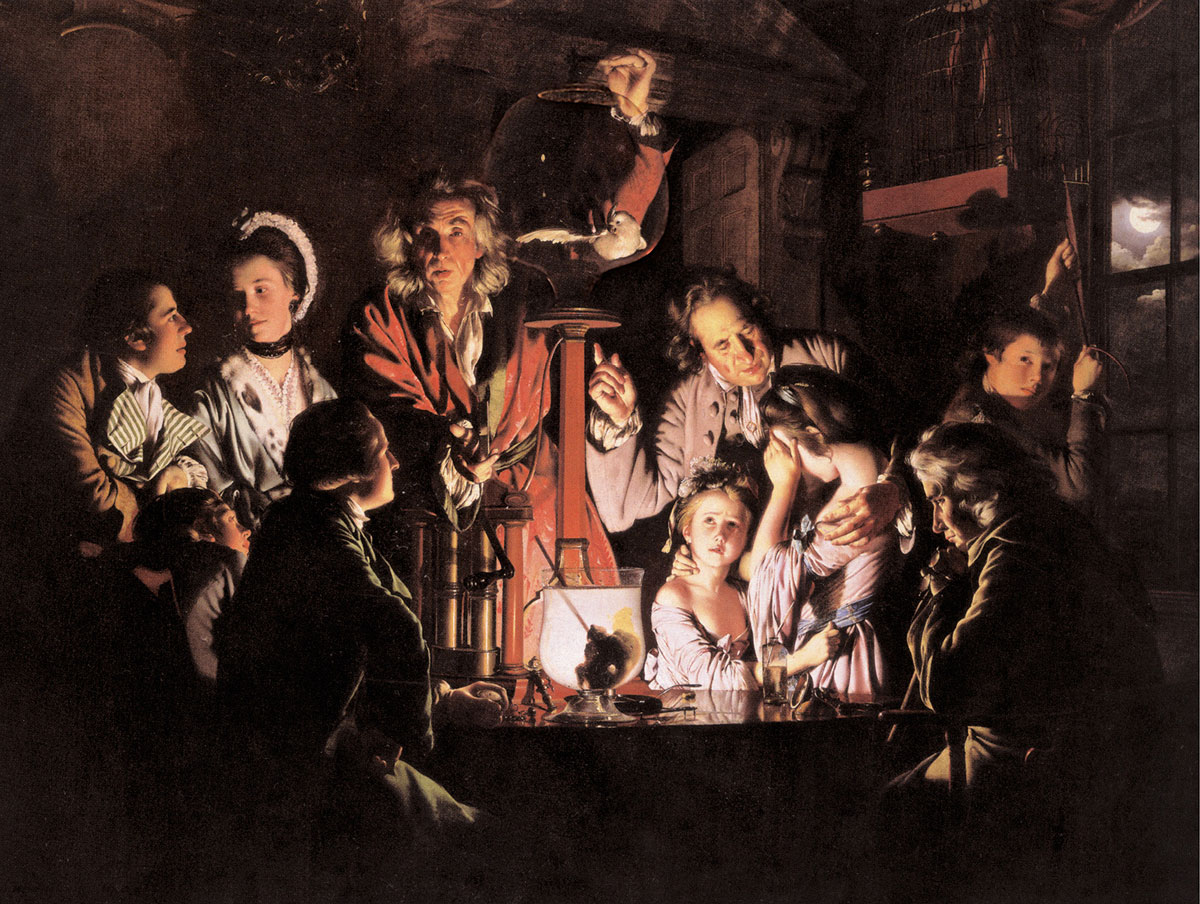
In his On the Natural Faculties (179 CE), physician and philosopher Claudius Galen explains the growth of animal organisms by using the image of a balloon—or rather the balloon of antiquity, an inflated animal bladder. “Children [in the district of Ionia] take the bladders of pigs, fill them with air, and then rub them on ashes near the fire, so as to warm, but not to injure them. … As they rub, they sing songs, to a certain measure, time, and rhythm, and all their words are an exhortation to the bladder to increase in size. When it appears to them fairly well distended, they again blow air into it and expand it further; then they rub it again. This they do several times, until the bladder seems to them to have become large enough.” Large enough to play with, that is. Galen’s focus, however, is on the increasing thinness of the bladder’s membrane. Were human bodies to grow in the same way, they might be “torn through,” and to prevent this, Nature provides “nourishment to this thin part.” Through nutrition, Nature alone possesses “the power to expand the body in all directions so that it remains un-ruptured and preserves completely its previous form.” Without nutrition, Galen’s image suggests, human bodies would pop, like over-distended balloons.
Galen’s balloon metaphor for bodily growth reflected antiquity’s conception of the “pneuma,” a breath-borne soul-like entity assumed to circulate and affect the body through what is now understood as the arterial system. The church fathers Christianized the pneuma, infusing it with monotheistic import, and indeed the word pneumatology is still used today to describe the study of the Holy Spirit. Although the discoveries of Renaissance anatomists offered evidence that challenged the idea that human breath filled the body with a divine “vital spirit,” it was during the Enlightenment that the pneuma/respiratory processes of animal bodies began to be secularized, as depicted most famously in Joseph Wright of Derby’s An Experiment on a Bird in the Air Pump (1768), a painting in which a white dove, perhaps retrospectively a synonym for the precariousness of Christianity itself, gasps for breath in a recreation of Robert Boyle’s experiments on the nature of air. Numerous paintings by Wright depict children blowing into, fighting over, and, in one case, simply gazing enquiringly upon an inflated pig’s bladder, a genre that not only recalls Galen but also represents an iconographic continuum with the vanitas motif known as homo bulla (meaning “man is a bubble”) in which the ephemerality of human life was equated with the fragile walls of an air-filled soap bubble. By the mid-nineteenth century, however, respiration was understood primarily in mechanistic terms. An 1869 lithograph in London’s Wellcome Collection, documenting the work of anatomist Francis Sibson, shows the lungs of a dissected cadaver ballooning outwards beneath an exposed ribcage as the result of air supplied through a tapped pump inserted into its trachea.
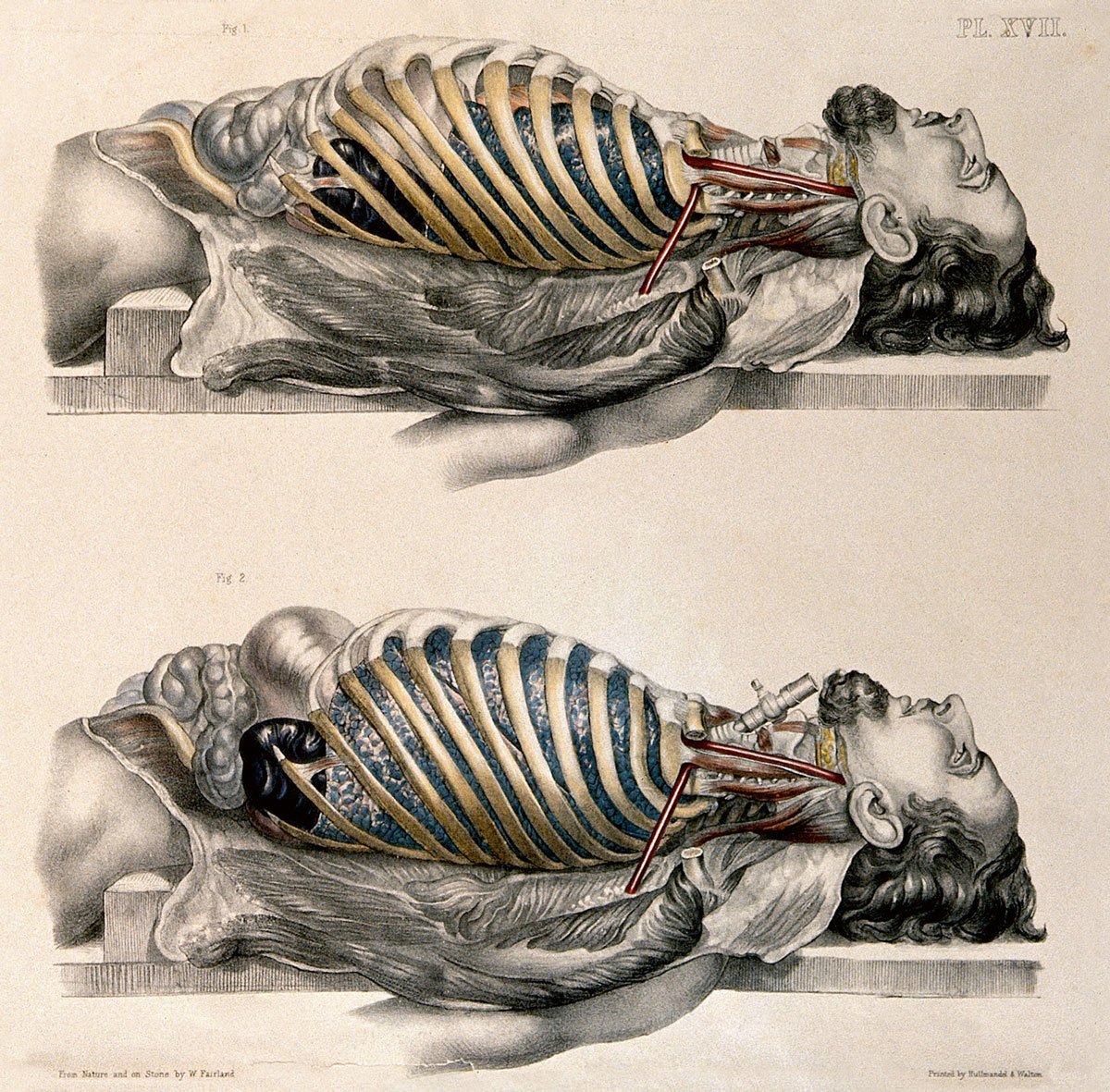
Almost fifty years earlier, in 1824, the English chemist and physicist Michael Faraday invented the rubber balloon while experimenting with hydrogen at London’s Royal Institution. Faraday selectively powdered two sheets of sticky caoutchouc (natural rubber) with flour before cutting and pressing together the edges to form an airtight pocket. His discovery was marketed in London just a year later in kit form by Thomas Hancock (the curious public had to make their own balloons), and in a more stable vulcanized form by J. G. Ingram in 1847. Around 1903, seamless balloons produced by dipping molds into a rubber cement compound entered the marketplace (the US patent for the process was given to the Rubber Balloon Company of America, based in Brooklyn, New York), but it was not until 1931, when the young American chemist Neil Tillotson dipped his molds into liquid latex, that the first modern toy balloon was inflated. A novelty company in Boston named C. Decieco & Son bought two thousand of Tillotson’s first product, a balloon with a hand-drawn cat’s face and pointed ears. Balloons bearing the “Tilly” name remain in production to this day, while from his home in Dixville Notch, New Hampshire, Tillotson himself earned additional fame as the first voter in every US presidential election from 1960 until his death in 1991.
The rubber toy balloon should here be distinguished from the wider category of reusable inflatable structures that include, among a vast miscellany of human inventiveness, buoyancy aids, dirigible vehicles, inflatable architecture, military decoys, gold-lined gastric balloons, and blow-up sex dolls. In contrast, the transient balloon inhabits a less stable dimension of the aerial imagination. Precariously thin-walled and thus prone to sudden permanent disintegration or slow entropic deflation, the balloon remains a colorful motif of celebratory frivolousness and enchanted vulnerability. In descriptors such as “depressed” and “deflated,” “buoyant” and “puffed-up,” we can perhaps detect an unconscious identification with the balloon, whose tactile and visual resemblance to the human body compels both fetishism (globophilia) and fear (globophobia) in not uncommon equal measure; it is perhaps unsurprising that Freud equated a flaccid balloon in a dream with a male sexual member of similar detumescence. Frustrated potency and balloons can be observed together elsewhere in the context of political protests, where balloon releases are used to articulate a diverse range of grievance. Black balloons, to take just one example of helium-assisted resistance, have been released skyward to variously highlight papal shame (St. Pölten, Austria, 1998), the Palestinian nakba (Jerusalem, Israel/Palestine, 2008), and carbon emissions (Adelaide, Australia, 2009).
American entertainers in the 1930s, like Herman J. “Balloons” Bonnert and Henry Maar, “The Sultan of Balloons,” and their British counterparts such as Dave “Windy Blow” Cecil in the late 1940s, were some of the first to realize the sculptural possibilities offered by Tillotson’s technology, although the balloon forms they modeled were limited due to the size, color, and durability of available products. Maar compensated for this deficiency by employing the kinetic and acoustic potential of the medium, as can be read within his promotional leaflets: “Wait until you see his ‘flying sausages’ sail over your audience and return like an Australian Boomerang to the stage. … Wait until you hear his delayed action ‘atomic bomb balloon.’” The balloon modeler’s association with clowning is never distant, the balloon itself representing an historical echo of the jester’s bauble or bladder-stick, an air-inflated, hand-squeezed prop that provided subversive flatulent merriment to medieval audiences. As technology permitted the development of longer, thinner, stronger, and more brightly colored balloons, the structures that practitioners embarked upon become increasingly complex, and today balloon “twisters” can choose from a wide range of sizes and a substantial palette in the pursuit of ever-increasing sculptural verisimilitude. Following in Thomas Hancock’s entrepreneurial footsteps, the balloon world’s current “Godfather,” Marvin Hardy, democratized the medium in 1983 by marketing “Balloon Magic”—the first balloon modeling kit, complete with pump—of which he sold fifty-seven thousand units in just two years.
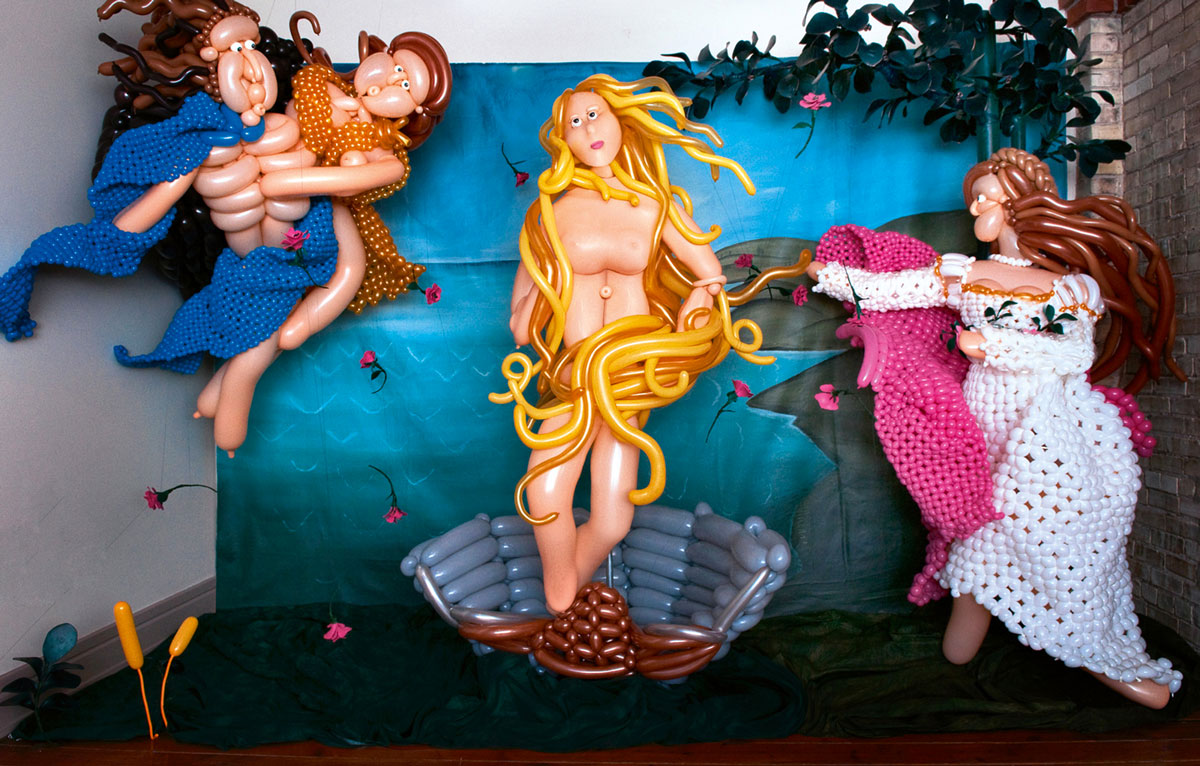



Despite the increasing professionalization of the field, it should be remembered that balloon modelers primarily engage their public through a gift economy. Whether it is a balloon dog handed to a child or an “adult” balloon twisted for a cabaret audience, the balloon gift’s aim, which is to establish a bond between individuals that circumvents commodity exchange, links it tangentially to transformative, often subversive modes of human connectedness. It is interesting to note therefore that Balloon HQ, one of the earliest (1991) and busiest non-academic online community forums to emerge during the nascent years of the Internet, thrived as a result of the free interchange of information among its international membership. The balloon-twisting world has since become so populous as to warrant regular international conventions, the first of which took place in 1998 in Melle, Germany followed a year later by the balloon world’s Woodstock, TJAM ’99, in Austin, Texas. Naomi Greenfield and Sara Taksler documented the vivacity, heterogeneity, and occasional internal wrangling of the convention community in Twisted—A Balloonamentary (2007).
Alongside Jeff Koons’s notorious ten-foot-high, chrome-plated Balloon Dog (1994–2000), the history of art and balloon modeling overlap in the work of two American contemporary balloon practitioners, Ralph Dewey and Larry Moss. Dewey began twisting balloons in the mid-1970s and is best known as the pioneer of “gospel ballooning,” in which the medium is deployed in the service of evangelical Christianity. One of Dewey’s notable balloon tableaux recreates Leonardo da Vinci’s Last Supper, first constructed (with colleagues) for the Fellowship of Christian Magicians convention in Marion, Indiana in 2004. In Dewey’s chromatic thirteen-figure composition, the ephemerality that lies at the heart of the medium sits in self-consciously ludicrous opposition to the historical and material durability of Leonardo’s original. However, in keeping with the utility of the latter—the fresco would have helped to focus devotion during Dominican mealtimes in the dining hall of Santa Maria delle Grazie in Milan—Dewey’s Last Supper draws together an industrious community of believers each time it is modeled. Among other subjects, Dewey and fellow artisans have ballooned Jesus walking on water, Zaccheaus in the tree, and the garden of Eden, and a cycle of museum-diorama-style scenes of the entire life of Christ is planned, funds permitting. Given that gospel twisters often analogize the breath with which they inflate their balloons to the life-granting breath of God, gospel ballooning can be seen as a variation of pneumatological theologizing manifest through a productive social ritual that balances devotion, proselytizing, and a certain reverent irreverence.
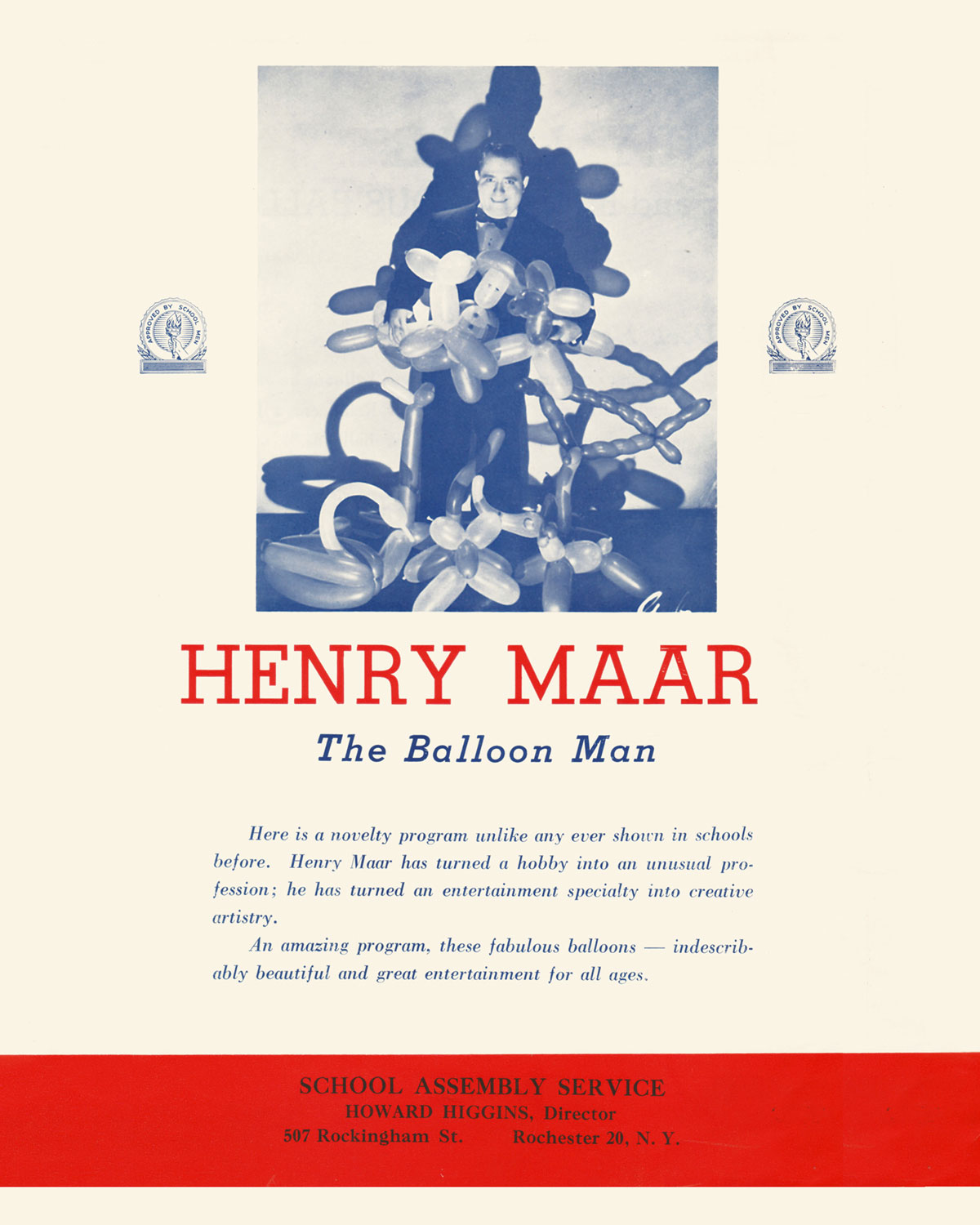
Secular rather than transcendent inflated bodies feature more prominently in the work of Larry Moss, founder of the aforementioned Balloon HQ website. Together with Todd Neufeld and Don Caldwell, Moss recently created a tableau on the lawn of the Obama White House in which inflated caricatures of Thomas Jefferson, George Washington, and Benjamin Franklin could be seen signing the Declaration of Independence in close proximity to a balloon-rendered American flag and bald eagle. Moss is the current world record holder for a structure comprised entirely of the largest number of “non-round” balloons (forty thousand), and furthermore the originator of “Balloon Manor,” an annually inflated ten-thousand-square-foot, ten-room balloon haunted house. Moss’s relationship to art historical subject matter can be seen as a parodying critique of value in which painted backdrops are combined with virtuoso latex-modeled elements to deliver satisfyingly skewed versions of popular art historical icons such as Leonardo’s Vitruvian Man, Wood’s American Gothic, Whistler’s Mother, and Pollock’s Blue Poles. If mass reproduction has long ago dislodged the Benjaminian auratic in these iconic works, then Moss offers a temporary, albeit knowingly kitsch, reinstatement in the form of his own fugitive breath. His most ambitious pastiche to date is a version of Botticelli’s Birth of Venus, which borders on self-reflexivity given that a balloon Venus is blown ashore by puffed-cheeked Zephyrs who purse their lips in the same respiratory gesture that defines his medium. Leonardo and Botticelli clashed during the Florentine Renaissance, the former chiding the latter for his departure from naturalism and pagan subject matter. United by mutual professional respect and perhaps by the hubris-deflating transitoriness of air-filled latex, Dewey and Moss remain friends.
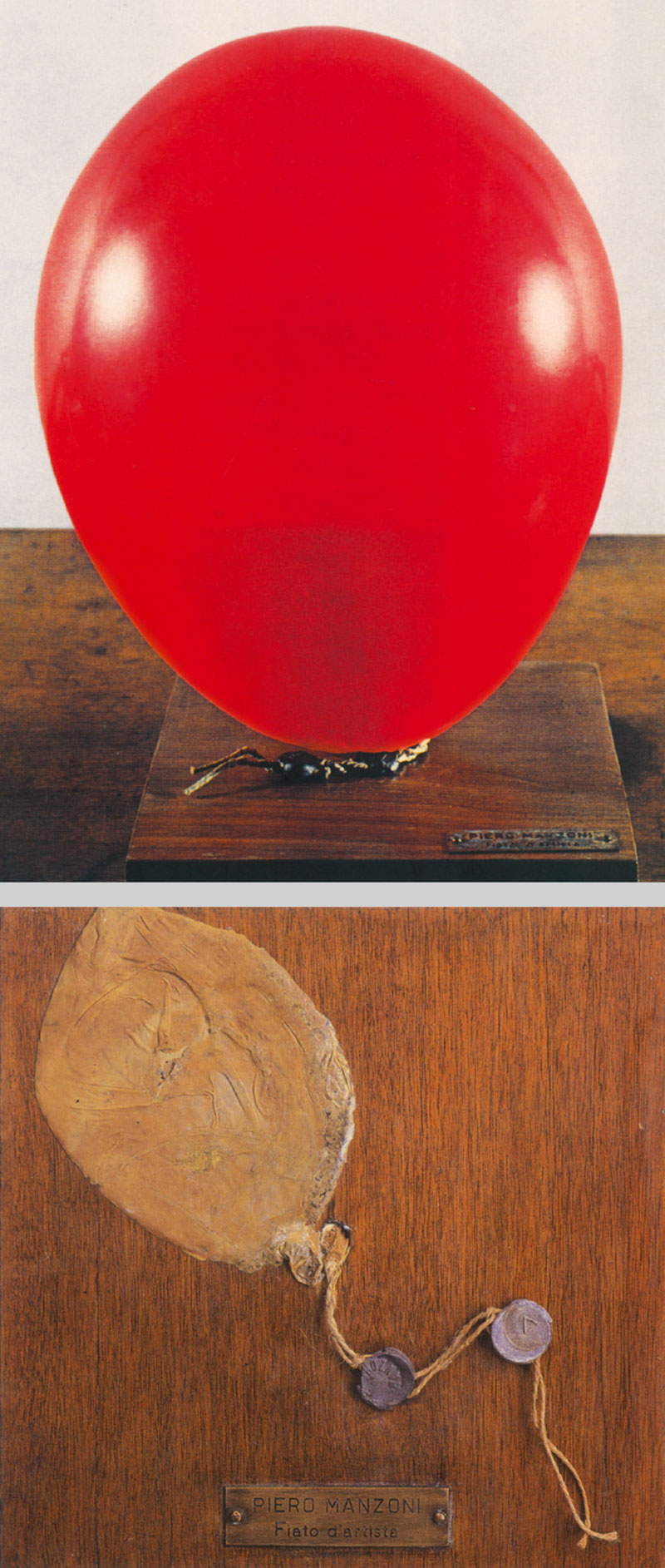
Another art-world balloon inflated as an implicit critique of cultural hegemony was Fiato d’artista (1960), an editioned work by Italian conceptual artist Piero Manzoni (1933–1963). Just four years after the release of Albert Lamorisse’s internationally acclaimed and widely distributed short film The Red Balloon (France, 1956), Manzoni marketed his own breath, captured within an inflatable not dissimilar to that which had uncannily accompanied Lamorisse’s young hero, valuing each exhalation at two hundred lire per liter. The contents of the balloons leaked away within a few weeks, of course, leaving art collectors in possession of a secular but nevertheless enchanted relic of the artist in the form of shriveled red latex, a balloon-body corpse attached by string to a small wooden plinth. An example of the work recently sold at auction for $34,243.
Jonathan Allen is a London-based artist and writer. He has recently co-curated “Magic Show,” a Hayward Gallery exhibition touring to venues in the United Kingdom during 2010. For more information, see www.jonathanallen.info.